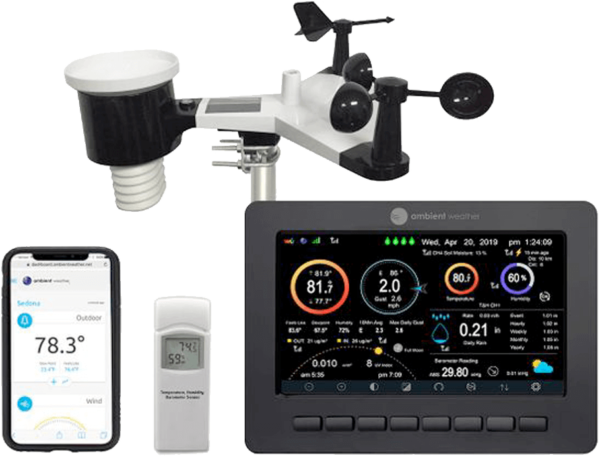A weather station is a product designed to provide a suite of localized environmental measurements in a fixed location. However, weather stations provide more information that’s found from the local weather channel.
While local weather from a news station or airport might give you the temperature, wind, and a general forecast, personal weather stations encompass much more data. For example, Ambient Weather’s Personal Weather stations deliver an array of measurements such as barometric pressure, solar radiation, and even indoor temperature and humidity.
The weather station designed for home can provide you’ll find from your local weather channel or app but personalized for your individual location-based on microclimate data. Depending on the model, this data will also refresh more frequently than other sources with live updates on conditions every 4 – 16 seconds.
Accurate Weather Station Models: Weather Enthusiast Favorites
Ambient Weather offers multiple weather station models that all contain the same functions at their core, but each offers a unique experience that is select to that certain model. The following comparison uses the 2 weather stations by AW and professional.

WS-2000 – $289.99, Provides Accurate Measurements for:
- Dew Point
- Forecast
- Heat Index
- Indoor Humidity
- Indoor Temp
- Moonphase
- Moonrise and Moonset
- Outdoor Humidity
- Outdoor Temp
- Rainfall
- Pressure
- Solar Radiation
- Sunrise and Sunset
- UV, Wind Direction
- Windspeed
- Windchill
WS-5000 – $349.99, Provides Accurate Measurements for:
- Dew Point
- Forecast
- Heat Index
- Indoor Humidity
- Indoor Temp
- Moonphase
- Moonrise and Moonset
- Outdoor Humidity
- Outdoor Temp
- Rainfall
- Pressure
- Solar Radiation
- Sunrise and Sunset
- Ultrasonic Wind
- UV
- Wind Direction,
- Windspeed
- Windchill
There are many key sensors that can be found on the weather stations that account for all the measurements taken. Among those components that take measurements are:
- Thermometer – measures temperature by measuring the expansion or contraction of mercury
- Barometer – measures barometric pressure by balancing the weight of mercury against the atmospheric pressure
- Weather Vane – measures wind speed and direction by naturally adjusting to the wind direction on a swivel while the fan on the top calculates the wind speed
- Large Rain Cup – measures rainfall by collecting any precipitation
- Ultrasonic sensor array – measures ultrasonic ways reflecting from objects through cameras
How Accurate are the WS-5000 Weather Stations?
Similar to the design and functionality of the arrays, there is a similar relationship with price and accuracy, and frequency of the weather stations. The accuracy for the WS- 5000 reads as the following,
- Temperature both indoor and outdoor +/- 2 degrees
- Humidity both indoor and outdoor +/- 2 degrees
- Solar radiation +/- 15%
- UV accuracy +/- 1
- Rainfall accuracy +/- 5%
- Windspeed accuracy < 22mph +/- 1mph, >22mph +/- 5mph
- Wind direction +/-5 degrees
- All the models from Ambient Weather offer a refresh rate in accordance to being connected to a WiFi network of 16 second intervals. When it comes to the WS-5000, that model can provide a refresh rate of 4.9 seconds, giving more accurate data at a greater distance at ¼ of the time that the other models offer.
When it comes to connecting a weather station, there are many options in which data can be exported for the use of the consumer. Connection to WiFi is the best choice to get the new weather station to upload its data. If the option to upload data is selected, then it will be pooled in with the community to create a large-scale map filled with the data from other stations around the country.
Siting & Mounting Options for Personal Weather Stations
Are you wondering how to site your weather station array? This is an important consideration, as it’s one of the first steps to take when you invest in a weather station. The mounting site should be tested for one week at a temporary location, making it easy to access as needed.
The temporary mounting site allows you to track and measure how your weather station is performing. In the meantime, it allows you to learn how the weather station functions while becoming familiar with the system.
Where is the best place to mount your weather station? You’ll want to keep it away from radiant heat transfer coming from buildings. You can do this by keeping the weather station at least 5 feet from any building or structure. You’ll also want to mount it in direct sunlight and avoid wind or rain obstructions.
Furthermore, consider any type of radio interference that might occur with your weather station. This includes radios, TVs, and computers. In terms of wireless range, the maximum distance is 100 feet.
Experiencing a New World with Personal Weather Stations
Personal weather stations provide an experience beyond what you receive from a weather app or local TV station. Choosing the right station as well as mounting site and mounting accessories can further improve accuracy and your experience. Be sure to explore all personal weather stations and get ready to immerse yourself in the world of weather around you.

